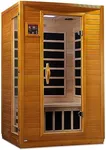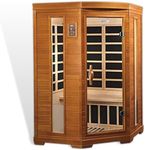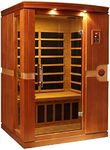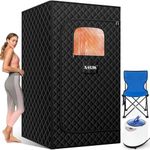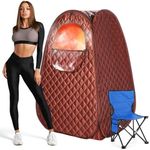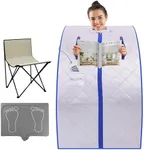Buying Guide for the Best Portable Home Saunas
Choosing the right portable home sauna can greatly enhance your relaxation and wellness routine. Portable saunas are a convenient way to enjoy the benefits of a sauna without the need for a permanent installation. When selecting a portable home sauna, it's important to consider several key specifications to ensure you get the best fit for your needs. Here are the main factors to consider and how to navigate them.Type of SaunaPortable saunas come in different types, such as infrared, steam, and traditional dry saunas. Infrared saunas use infrared heaters to emit radiant heat, which is absorbed directly by the body. Steam saunas use a steam generator to produce moist heat, while traditional dry saunas use heated rocks to create a dry heat environment. The type of sauna you choose will depend on your personal preference for heat and humidity levels. Infrared saunas are generally more energy-efficient and heat up faster, while steam saunas provide a more intense sweating experience.
Size and CapacityThe size and capacity of a portable sauna are important to consider based on the space you have available and how many people will be using it. Saunas come in various sizes, from single-person units to larger models that can accommodate two or more people. Measure the space where you plan to set up the sauna and ensure it will fit comfortably. If you plan to use the sauna with a partner or family members, opt for a larger capacity model.
Heating ElementsThe type and quality of heating elements in a sauna can affect its performance and your overall experience. Infrared saunas typically use carbon or ceramic heaters. Carbon heaters provide even heat distribution and are more energy-efficient, while ceramic heaters heat up faster and can reach higher temperatures. Steam saunas use a steam generator, and the power of the generator will determine how quickly the sauna heats up. Consider your preference for heat intensity and distribution when choosing the heating elements.
Temperature RangeThe temperature range of a sauna indicates how hot it can get. Infrared saunas usually operate at lower temperatures (around 120-150°F) compared to steam and traditional saunas (which can reach up to 200°F). If you prefer a milder heat, an infrared sauna might be more suitable. For those who enjoy higher temperatures and more intense sweating, a steam or traditional sauna would be a better choice. Consider your comfort level and health needs when evaluating the temperature range.
Portability and SetupOne of the main advantages of a portable sauna is its ease of setup and portability. Look for saunas that are lightweight, easy to assemble, and can be quickly disassembled for storage or transport. Some models come with foldable chairs and compact designs that make them easy to move around. If you plan to use the sauna in different locations or need to store it away when not in use, prioritize models that offer greater portability and simple setup.
Material and Build QualityThe materials used in the construction of a portable sauna can affect its durability, heat retention, and overall comfort. Common materials include wood, fabric, and plastic. High-quality wood, such as cedar, is often used in traditional saunas for its natural resistance to moisture and pleasant aroma. Fabric saunas are lightweight and easy to set up but may not retain heat as well. Consider the build quality and materials to ensure the sauna will last and provide a comfortable experience.
Additional FeaturesSome portable saunas come with additional features that can enhance your experience, such as built-in speakers, chromotherapy lighting, and digital controls. Built-in speakers allow you to listen to music or guided meditations, while chromotherapy lighting uses colored lights to promote relaxation and healing. Digital controls make it easy to adjust the temperature and timer settings. Consider which additional features are important to you and will enhance your sauna experience.

